2006 SUBARU IMPREZA tow
[x] Cancel search: towPage 13 of 365
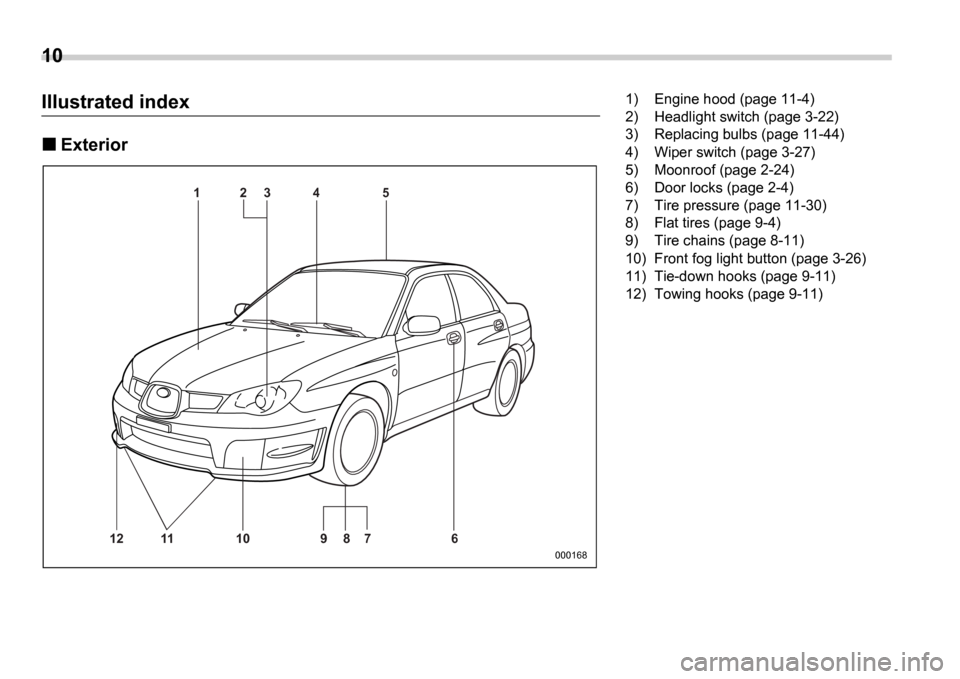
10
Illustrated index
Exterior
1 2 34 5
12 11 10 9 87 6
000168
1) Engine hood (page 11-4)
2) Headlight switch (page 3-22)
3) Replacing bulbs (page 11-44)
4) Wiper switch (page 3-27)
5) Moonroof (page 2-24)
6) Door locks (page 2-4)
7) Tire pressure (page 11-30)
8) Flat tires (page 9-4)
9) Tire chains (page 8-11)
10) Front fog light button (page 3-26)
11) Tie-down hooks (page 9-11)
12) Towing hooks (page 9-11)
Page 14 of 365
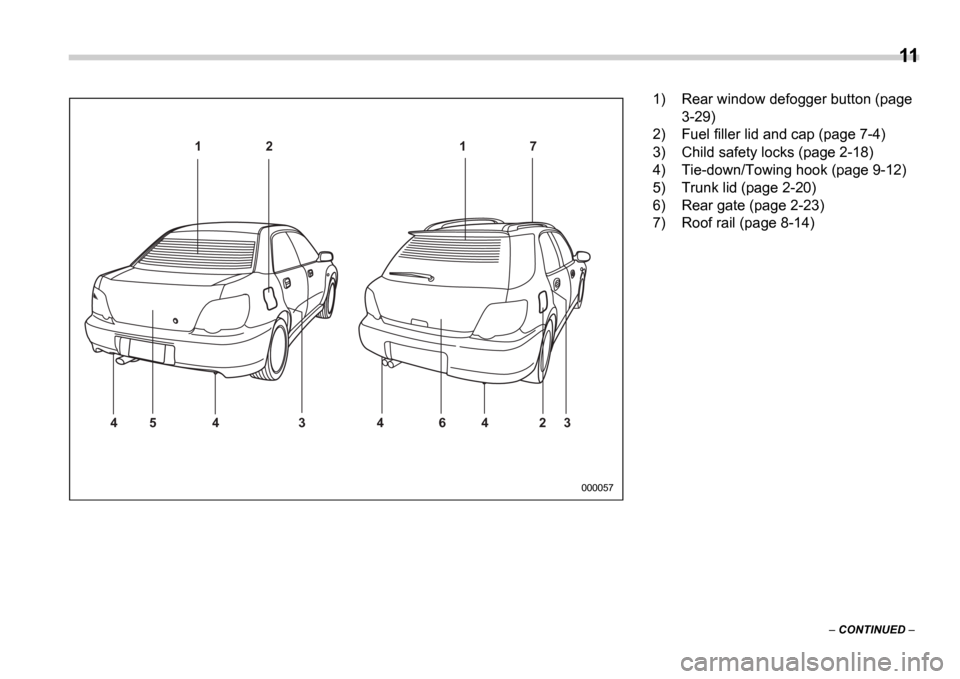
11
CONTINUED
1 2
3 4 4 6 2 3
4
4 5 1 7
000057
1) Rear window defogger button (page
3-29)
2) Fuel filler lid and cap (page 7-4)
3) Child safety locks (page 2-18)
4) Tie-down/Towing hook (page 9-12)
5) Trunk lid (page 2-20)
6) Rear gate (page 2-23)
7) Roof rail (page 8-14)
Page 66 of 365
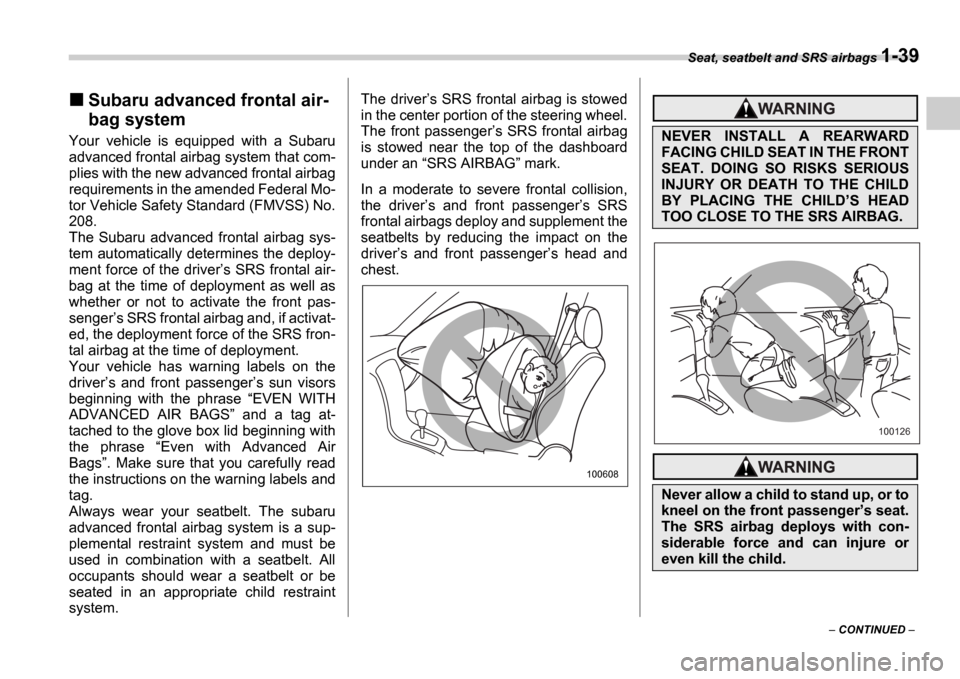
Seat, seatbelt and SRS airbags 1-39
CONTINUED
Subaru advanced frontal air-
bag system
Your vehicle is equipped with a Subaru
advanced frontal airbag system that com-
plies with the new advanced frontal airbag
requirements in the amended Federal Mo-
tor Vehicle Safety Standard (FMVSS) No.
208.
The Subaru advanced frontal airbag sys-
tem automatically determines the deploy-
ment force of the driver s SRS frontal air-
bag at the time of deployment as well as
whether or not to activate the front pas-
senger s SRS frontal airbag and, if activat-
ed, the deployment force of the SRS fron-
tal airbag at the time of deployment.
Your vehicle has warning labels on the
driver s and front passenger s sun visors
beginning with the phrase EVEN WITH
ADVANCED AIR BAGS and a tag at-
tached to the glove box lid beginning with
the phrase Even with Advanced Air
Bags . Make sure that you carefully read
the instructions on the warning labels and
tag.
Always wear your seatbelt. The subaru
advanced frontal airbag system is a sup-
plemental restraint system and must be
used in combination with a seatbelt. All
occupants should wear a seatbelt or be
seated in an appropriate child restraint
system. The driver
s SRS frontal airbag is stowed
in the center portion of the steering wheel.
The front passenger s SRS frontal airbag
is stowed near the top of the dashboard
under an SRS AIRBAG mark.
In a moderate to severe frontal collision,
the driver s and front passenger s SRS
frontal airbags deploy and supplement the
seatbelts by reducing the impact on the
driver s and front passenger s head and
chest.
100608
NEVER INSTALL A REARWARD
FACING CHILD SEAT IN THE FRONT
SEAT. DOING SO RISKS SERIOUS
INJURY OR DEATH TO THE CHILD
BY PLACING THE CHILD S HEAD
TOO CLOSE TO THE SRS AIRBAG.
Never allow a child to stand up, or to
kneel on the front passenger s seat.
The SRS airbag deploys with con-
siderable force and can injure or
even kill the child.
100126
Page 67 of 365
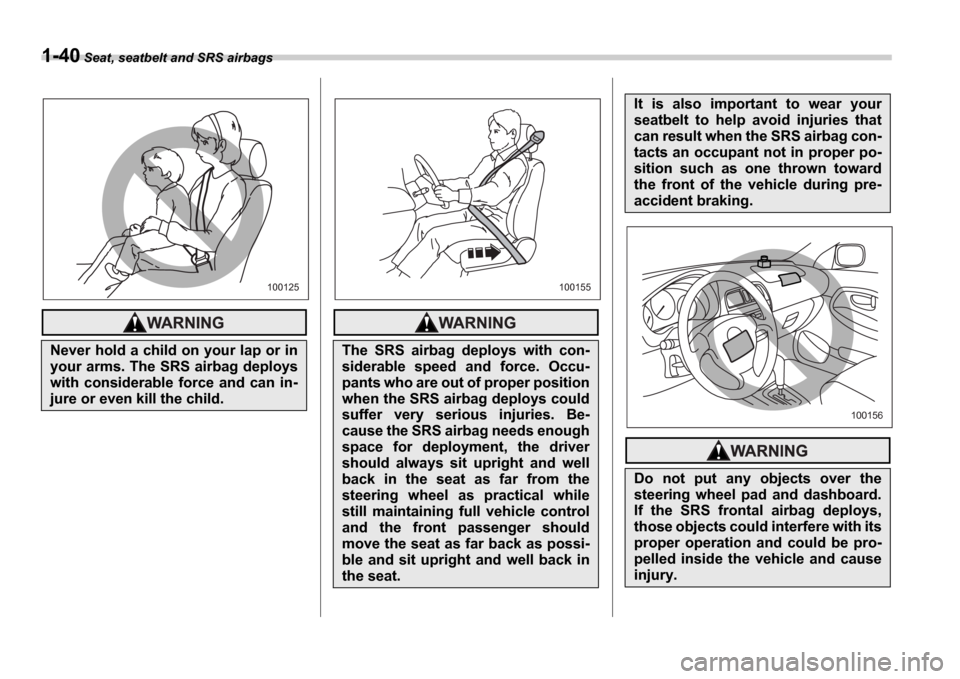
1-40 Seat, seatbelt and SRS airbags
Never hold a child on your lap or in
your arms. The SRS airbag deploys
with considerable force and can in-
jure or even kill the child.
100125
The SRS airbag deploys with con-
siderable speed and force. Occu-
pants who are out of proper position
when the SRS airbag deploys could
suffer very serious injuries. Be-
cause the SRS airbag needs enough
space for deployment, the driver
should always sit upright and well
back in the seat as far from the
steering wheel as practical while
still maintaining full vehicle control
and the front passenger should
move the seat as far back as possi-
ble and sit upright and well back in
the seat.
100155
It is also important to wear your
seatbelt to help avoid injuries that
can result when the SRS airbag con-
tacts an occupant not in proper po-
sition such as one thrown toward
the front of the vehicle during pre-
accident braking.
Do not put any objects over the
steering wheel pad and dashboard.
If the SRS frontal airbag deploys,
those objects could interfere with its
proper operation and could be pro-
pelled inside the vehicle and cause
injury.
100156
Page 79 of 365
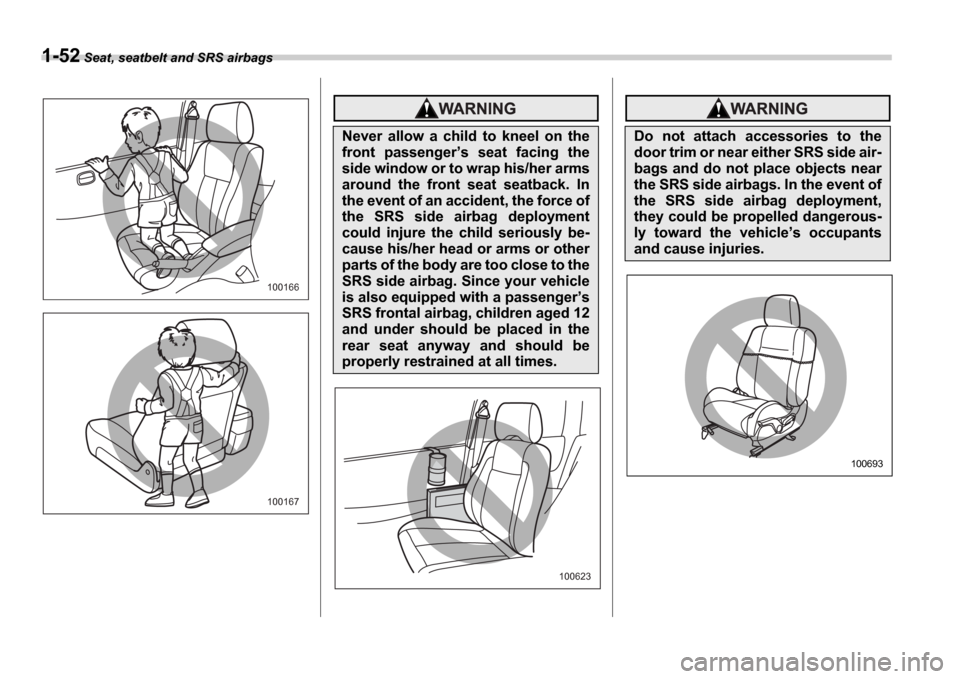
1-52 Seat, seatbelt and SRS airbags
100166
100167
Never allow a child to kneel on the
front passenger s seat facing the
side window or to wrap his/her arms
around the front seat seatback. In
the event of an accident, the force of
the SRS side airbag deployment
could injure the child seriously be-
cause his/her head or arms or other
parts of the body are too close to the
SRS side airbag. Since your vehicle
is also equipped with a passenger s
SRS frontal airbag, children aged 12
and under should be placed in the
rear seat anyway and should be
properly restrained at all times.
100623
Do not attach accessories to the
door trim or near either SRS side air-
bags and do not place objects near
the SRS side airbags. In the event of
the SRS side airbag deployment,
they could be propelled dangerous-
ly toward the vehicle s occupants
and cause injuries.
100693
Page 91 of 365
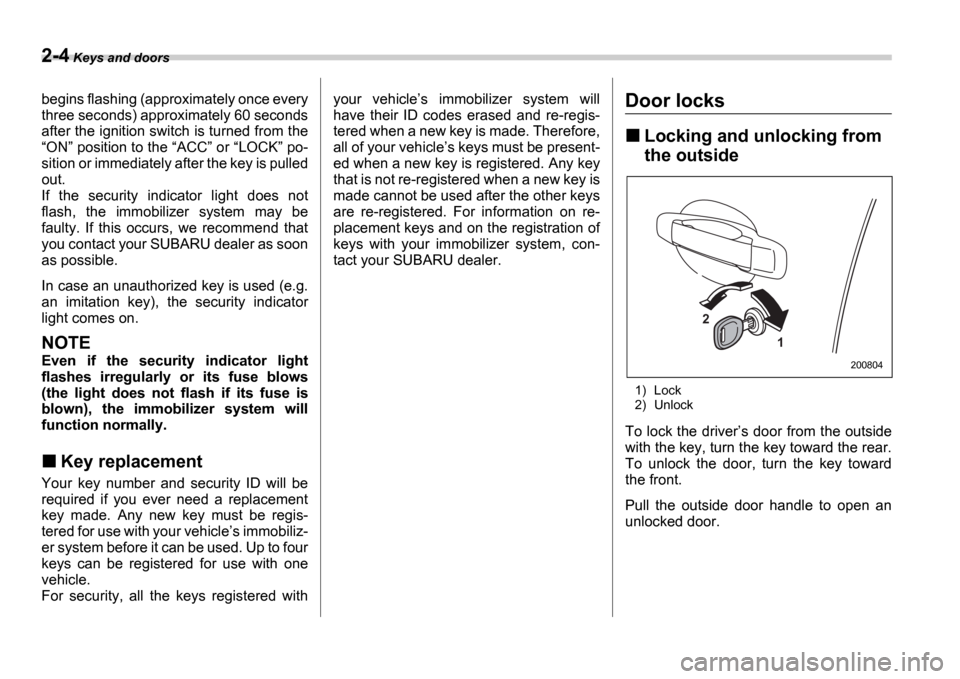
2-4 Keys and doors
begins flashing (approximately once every
three seconds) approximately 60 seconds
after the ignition switch is turned from theON position to the ACC or LOCK po-
sition or immediately after the key is pulled
out.
If the security indicator light does not
flash, the immobilizer system may be
faulty. If this occurs, we recommend that
you contact your SUBARU dealer as soon
as possible.
In case an unauthorized key is used (e.g.
an imitation key), the security indicator
light comes on.
NOTE
Even if the security indicator light
flashes irregularly or its fuse blows
(the light does not flash if its fuse is
blown), the immobilizer system will
function normally.
Key replacement
Your key number and security ID will be
required if you ever need a replacement
key made. Any new key must be regis-
tered for use with your vehicle s immobiliz-
er system before it can be used. Up to four
keys can be registered for use with one
vehicle.
For security, all the keys registered with your vehicle
s immobilizer system will
have their ID codes erased and re-regis-
tered when a new key is made. Therefore,
all of your vehicle s keys must be present-
ed when a new key is registered. Any key
that is not re-registered when a new key is
made cannot be used after the other keys
are re-registered. For information on re-
placement keys and on the registration of
keys with your immobilizer system, con-
tact your SUBARU dealer.
Door locks
Locking and unlocking from
the outside
1) Lock
2) Unlock
To lock the driver s door from the outside
with the key, turn the key toward the rear.
To unlock the door, turn the key toward
the front.
Pull the outside door handle to open an
unlocked door.
2
1
200804
Page 94 of 365
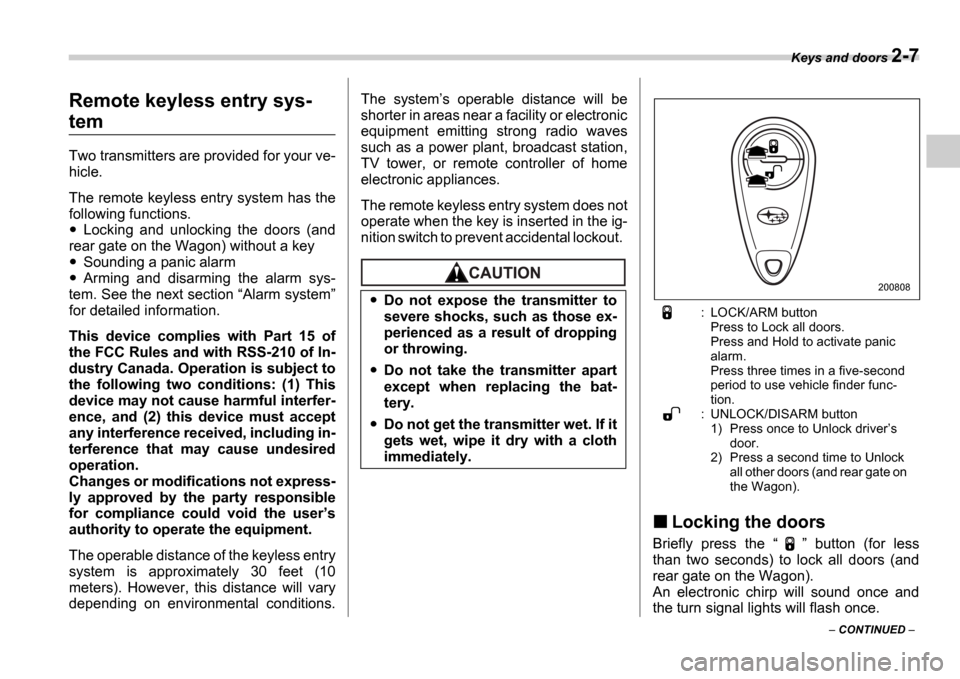
Keys and doors 2-7
CONTINUED
Remote keyless entry sys-
tem
Two transmitters are provided for your ve-
hicle.
The remote keyless entry system has the
following functions.
Locking and unlocking the doors (and
rear gate on the Wagon) without a key
Sounding a panic alarm
Arming and disarming the alarm sys-
tem. See the next section Alarm system
for detailed information.
This device complies with Part 15 of
the FCC Rules and with RSS-210 of In-
dustry Canada. Operation is subject to
the following two conditions: (1) This
device may not cause harmful interfer-
ence, and (2) this device must accept
any interference received, including in-
terference that may cause undesired
operation.
Changes or modifications not express-
ly approved by the party responsible
for compliance could void the user s
authority to operate the equipment.
The operable distance of the keyless entry
system is approximately 30 feet (10
meters). However, this distance will vary
depending on environmental conditions. The system
s operable distance will be
shorter in areas near a facility or electronic
equipment emitting strong radio waves
such as a power plant, broadcast station,
TV tower, or remote controller of home
electronic appliances.
The remote keyless entry system does not
operate when the key is inserted in the ig-
nition switch to prevent accidental lockout.
: LOCK/ARM button Press to Lock all doors.
Press and Hold to activate panic
alarm.
Press three times in a five-second
period to use vehicle finder func-
tion.
: UNLOCK/DISARM button 1) Press once to Unlock driver s
door.
2) Press a second time to Unlock
all other doors (and rear gate on
the Wagon).
Locking the doors
Briefly press the button (for less
than two seconds) to lock all doors (and
rear gate on the Wagon).
An electronic chirp will sound once and
the turn signal lights will flash once.
Do not expose the transmitter to
severe shocks, such as those ex-
perienced as a result of dropping
or throwing.
Do not take the transmitter apart
except when replacing the bat-
tery.
Do not get the transmitter wet. If it
gets wet, wipe it dry with a cloth
immediately.
200808
Page 116 of 365
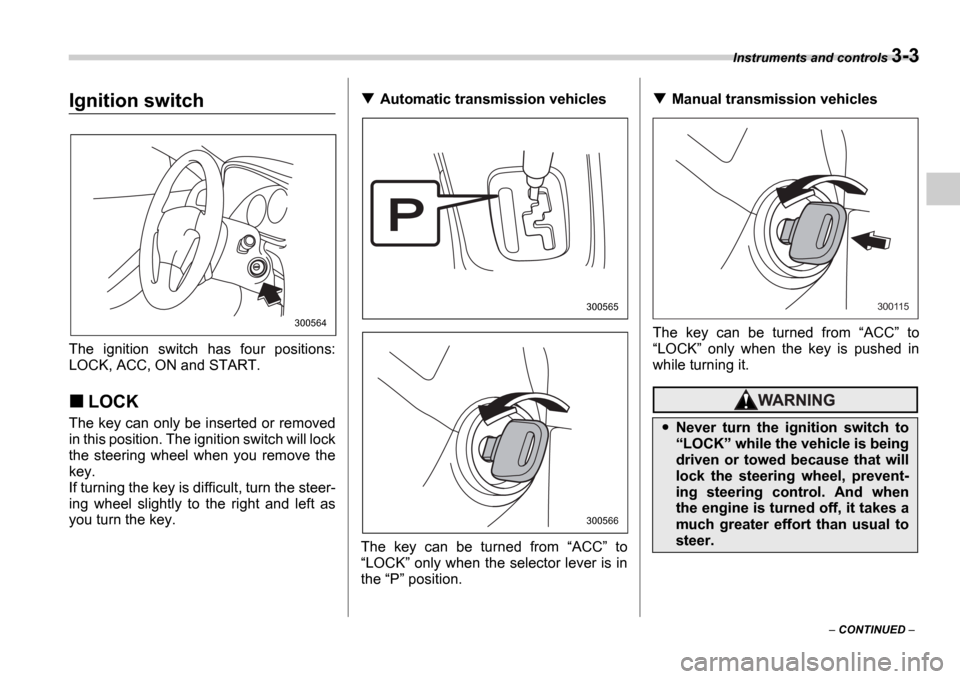
Instruments and controls 3-3
CONTINUED
Instrum ents and controlsIgnition switch
The ignition switch has four positions:
LOCK, ACC, ON and START.
LOCK
The key can only be inserted or removed
in this position. The ignition switch will lock
the steering wheel when you remove the
key.
If turning the key is difficult, turn the steer-
ing wheel slightly to the right and left as
you turn the key.
Automatic transmission vehicles
The key can be turned from ACC to
LOCK only when the selector lever is in
the P position.Manual transmission vehicles
The key can be turned from ACC to
LOCK only when the key is pushed in
while turning it.
300564
300565
300566
Never turn the ignition switch to LOCK while the vehicle is being
driven or towed because that will
lock the steering wheel, prevent-
ing steering control. And when
the engine is turned off, it takes a
much greater effort than usual to
steer.
300115